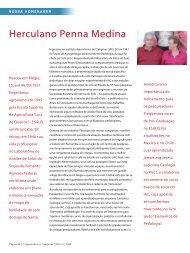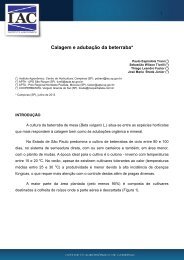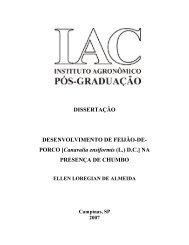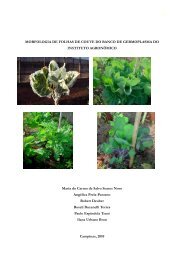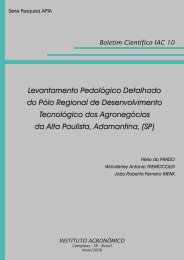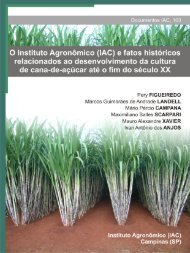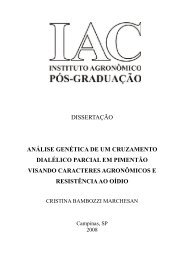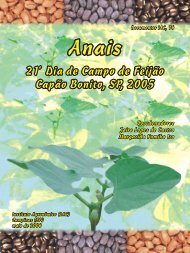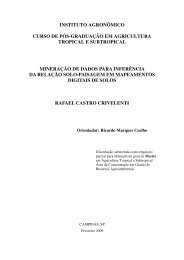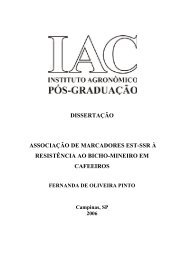vi seminário sobre pragas, doenças e plantas daninhas do ... - IAC
vi seminário sobre pragas, doenças e plantas daninhas do ... - IAC
vi seminário sobre pragas, doenças e plantas daninhas do ... - IAC
- No tags were found...
Create successful ePaper yourself
Turn your PDF publications into a flip-book with our unique Google optimized e-Paper software.
terms of the average number of nucleotide per motif (14 nucleotides in average) followed by compound<br />
motifs (12 nucleotides in average) which were represented by perfect and imperfect repeats.<br />
BLASTN and BLASTX were used to align the 123 microssatellite sequences to Genbank database.<br />
From these, 33 unigenes presented similarity to protein <strong>do</strong>mains with possible multiple functions. The<br />
most frequent category was the nucleic acid binding proteins (19% of the sequences similar) and it was<br />
followed by protein kinase related proteins and conserved genes of unknown function.<br />
Ultimately, a total of 123 microsatellites were characterized. The microsatellites had their<br />
annealing temperatures optimized and were evaluated in 6% acrylamide gels (Figure 1). A total of 93<br />
microsatellites were polymorphic (75.6%), 27 monomorphic (22.0%), and 3 (2.4%) did not amplify at<br />
all. All amplified products obtained for common bean accessions were of the expected range size.<br />
The allele number ranged from 2 to 9 alleles per locus with a 2.9 average value. PIC values varied<br />
from 0.04 to 0.83, 0.46 average value. The lowest PIC (0.04) was shown for microsatellite SSR-<br />
<strong>IAC</strong>60, which detained a core motif of five repetitive units, (TG) 5 . Middle American genetic distances<br />
ranged from 0.37 to 0.71, with 0.57 average value; Andean genetic distances varied from 0.50 to 0.80<br />
with 0.62 average value. Genetic distances among pairs of cultivars obtained from different gene<br />
pools ranged from 0.51 to 0.81 with 0.74 of average value. Cluster analysis allocated genotypes in<br />
two distinct groups according to their <strong>do</strong>mestication centers (Figure 2). The three principal coordinate<br />
analyses (Figure 3) di<strong>vi</strong>ded common bean materials in two main groups according to their Andean and<br />
Middle American origin reflecting the same group-association observed in the final dendrogram. Three<br />
materials, Tu (11, Middle American) Jabola (18, Andean) and Kaboon (12, Andean), and Fradinho Cruzeiro<br />
(19, Vigna spp.) were clearly depicted from the others. Essentially the same tendency represented by<br />
the dendrogram was observed by DUARTE et al. (1999) using RAPD markers: a clear separation among<br />
cultivars from Middle American and Andean South American <strong>do</strong>mestication centers.<br />
So far, the more microsatellites available for common bean, the better the genome mapping,<br />
as marker density of linkage maps can be increased. YU et al. (2000) reported that SSR sequences<br />
are fairly abundant in bean genome and widespread distributed. Once developed, microsatellites are<br />
ideal markers, stable and easy to assay by polymerase chain reaction. Several important genes such<br />
as the resistance genes may be linked to microsatellite motifs, which make them relevant for several<br />
genetically applied studies of germplasm characterization, mapping and marker assisted-selection.<br />
Documentos, <strong>IAC</strong>, Campinas, 79, 2007<br />
177



